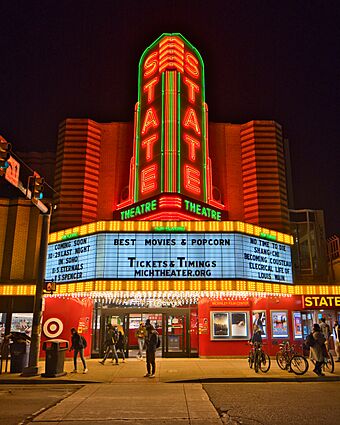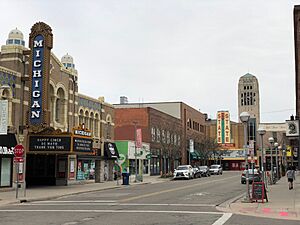State Theatre (Ann Arbor, Michigan) facts for kids
The State Theatre is a special movie theater in Ann Arbor, Michigan. It was designed in the cool Art Deco style. This style uses lots of geometric shapes and shiny materials.
The State Theatre was built by W. S. Butterfield Theatres. They also ran the Michigan Theater nearby. Today, a non-profit group called Marquee Arts runs the State Theatre. They have been in charge since 1999.
The theater now has four screens. These screens are located on the balcony of what used to be a huge auditorium. The main floor of the old auditorium became a retail store in 1989. It was an Urban Outfitters store until 2020. Now, a small Target store is there.
The State Theatre is in the middle of Ann Arbor. Its unique green, yellow, and red sign, called a marquee, makes it a famous landmark.
Contents
History of the State Theatre
How the State Theatre Began
In 1940, W.S. Butterfield Theatres had five movie theaters in Ann Arbor. One of them was the Majestic Theater. Butterfield wanted to fix up the Majestic. However, city officials did not allow the renovations. This led to the decision to build the State Theatre instead. The staff from the Majestic moved to the new State Theatre. It was seen as the Majestic's replacement. The Majestic building was later torn down in 1948.
Designing and Building the Theatre
In September 1940, Butterfield started planning a new theater. They cleared out a property at 221 South State Street. Weeks later, the plans for the new theater were shared. It was designed in the Art Deco style by C. Howard Crane. He was a famous architect from Detroit who designed many movie palaces.
The State Theatre was built specifically for showing movies. It had a small stage but no dressing rooms. The Michigan Theater was still used for live shows. Both theaters showed the newest movies.
The State Theatre opened with a big celebration on March 18, 1942. The first movie shown was The Fleet's In. Butterfield Theatres made sure everyone knew that construction started before the United States entered World War II. This meant no materials needed for the war were used. The State was also the first theater in Ann Arbor to have air conditioning.
Changes Over Time
The first big change to the State Theatre happened in November 1953. The original movie screen was replaced with a much larger one.
In 1979, the State Theatre was divided into a four-screen multiplex. This meant there were two movie rooms on the balcony and two on the main floor. The manager, Barry Miller, said this was done to help the theater financially. It also allowed them to show movies for longer periods.
Challenges and New Owners
In 1984, W. S. Butterfield Theatres sold several theaters, including the State. The new owner, George Kerasotes, tried to save money. He stopped discounts and replaced the trained projectionists with new staff. The projectionists and their supporters protested for months.
Kerasotes sold the State Theatre in 1989 to Hogarth Management. Hogarth was owned by Tom Borders, who started the Borders bookstore chain. His main store was very close to the State Theatre. Hogarth first wanted to turn the whole building into a store. But they decided to only change the ground floor. The two movie rooms on the balcony and the bright neon sign stayed.
An Urban Outfitters store opened on the ground floor in August 1989. You could still see parts of the old theater inside the store.
After being empty for a few years, Aloha Entertainment took over the movie part. They added Hawaiian decorations. The theater reopened on November 13, 1992. It showed older movies at lower prices. In 1997, a group of local investors bought the building. They ended Aloha's lease. In 1999, this group hired the Michigan Theater Foundation to run the State. This brought the Michigan and State theaters back together.
Bringing Back the Old Look
In 2007, the Michigan Theater Foundation made plans to take over the State. In 2013, the building's owners wanted to turn the upstairs theaters into apartments. The Michigan Theater Foundation offered to buy the whole building. They bought the theater parts, but not the retail space, in 2014.
A big renovation started in 2017. The goal was to bring back the original Art Deco style. Special tiles were made, and the old carpet pattern was recreated. The 2017 renovation created four modern theaters. They have better views and new projection and sound systems.
During and After the COVID-19 Pandemic
The State Theatre closed temporarily from March 2020 to February 2021 because of the COVID-19 pandemic. It opened briefly in October 2020. Even when closed, they showed movies online through a "Virtual Movie Palace."
The Urban Outfitters store on the ground floor moved to Briarwood Mall in November 2020. A Target store opened in that space in 2021. This Target is a "small-format" store. It sells a limited selection of items, focusing on groceries. It is one of the smallest Target stores, about 12,000 square feet.
In 2024, the Michigan Theater Foundation changed its name to "Marquee Arts."
What's Playing at the State Theatre?
Marquee Arts runs the State Theatre. The movies shown there are planned with the nearby Michigan. The State Theatre shows new independent films and classic movies. They also have regular late-night showings of popular cult films.



